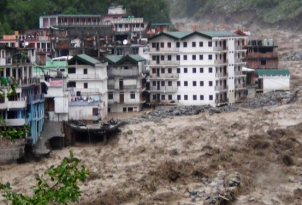
By Nick Meynen and Daniela del Bene.
When we wrote “Himalayan dams: goddamned!” last year and reported about the Uttarakhand floods, India’s worst ‘natural’ disaster since the 2004 tsunami (900 deaths, 5700 missing, 5000 broken roads, 200 broken bridges), we had to update the blog only a day later. The Supreme Court of India immediately ordered the government to to examine how“natural” it was or if damming the rivers and related infrastructures played a role in it. The court also directed the Ministry of the Environment to constitute an expert body to make a detailed report as to whether hydroelectric power projects existing and under construction have contributed to the environmental degradation and if so, to what extent. The “Assessment of Environmental Degradation and Impact of Hydroelectric Projects During The June 2013 Disaster in Uttarakhand” has now been released and in some respects, it is a bombshell.
The experts assessed that hydropower projects played a significant role in the Uttarakhand disaster and that there is an urgent need to improve the environment governance of hydropower projects. They also recommended that at least 23 of the 24 hydropower projects tagged as dangerous by Wildlife Institute of Indian should be dropped.
Himanshu Thakkar from The South Asia Network on Dams, Rivers and People (SANDRP) wrote an excellent in-depth reaction to this important report. Thakkar describes the battle between India’s Supreme Court and the national and regional government and the obvious conflict of interest in the expert body.
Here are his conclusions:
“In spite of certain weaknesses, most of the recommendations of the committee need to be immediately implemented and till they are implemented in letter and spirit, the Supreme Court should order a status quo on any further hydropower projects. The EB headed by Dr Ravi Chopra should be congratulated for this report in spite of difficult circumstances under which the committee operated.
* We also hope the Supreme Court would ask MoEF to order stoppage of work on Lakhwar and Vyasi projects that has been started recently, violating the Supreme Court order in letter and spirit, and also as pointed out by the EB.
* The work on 24 hydropower projects that was part of explicit TOR of the committee should be ordered to stop immediately. The EB should have made this explicit recommendation, but even if they have not done that, it is implicit in its recommendation.
* The Supreme Court should ask MoEF to provide a time bound action plan on implementation of the various recommendations of the EB. The SC an also possibly appoint EB (minus Dr Das, CWC and CEA persons) to oversee the implementation of the action plan and continue to provide independent feedback on adequacy of such implementation.
* The Lessons from Uttarakhand are relevant for all Himalayan states of India from Kashmir to all the North East states and we hope Supreme Court to ask the follow up committee to ensure that these lessons are taken note of and necessary steps flowing there from are implemented in these Himalayan states. These will also provide guidance to our Himalayan neighbouring countries.
* The failure of environmental governance is one of the clearest stark message from this episode and we hope MoEF will put its house in order in this respect, revamping its entire environmental governance.”
The report will now hopefully play a role in the debates before the world’s biggest election, slated for the coming weeks. As we reported earlier, a new party have taken claims for socio-environmental justice into its program and philosophy; among its candidates there are several activists who have devoted their lives to struggles against large infrastructures and the whole mania of growth-driven economic development. Maybe this is the right time to push for a serious discussion on the matter at political level, questioning the energy production model and, more broadly, the development model of the nation.
For more info on water related conflicts in India, check EJOLT: database and the reported 28 water management conflicts in India.

The project ENVJUSTICE has received funding from the European Research Council (ERC) under the European Union’s Horizon 2020 research and innovation programme (grant agreement No. 695446)